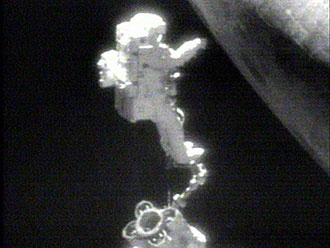Geotimes

Untitled Document

Web Extra
Thursday, August 4, 2005 Updated at 5:00
p.m., August 4
Shuttle repair rundown
 The repair
of the shuttle during a space walk Wednesday marked a first in the history of
NASA. Astronaut Steve Robinson smoothly removed material found protruding from
between the tiles on the belly of Discovery. "It looks like this
big patient is cured," Robinson said to flight controllers.
The repair
of the shuttle during a space walk Wednesday marked a first in the history of
NASA. Astronaut Steve Robinson smoothly removed material found protruding from
between the tiles on the belly of Discovery. "It looks like this
big patient is cured," Robinson said to flight controllers.
Attached to a mechanical
arm, astronaut Steve Robinson approached the underside of the space shuttle
Discovery yesterday morning, to remove a protruding space filler. NASA
deemed the repair, completed in about an hour, a success. Image is courtesy
of NASA.
The protrusions that concerned NASA officials were gap fillers — thin
pieces of hardened fabric placed between the shuttle's heat-protecting tiles
to restrict the flow of hot gas into the gaps. NASA wanted to make certain that
the protruding fillers would not add extra heating to the tiles, as Discovery
re-enters the atmosphere on Monday.
To access the damage, a robotic arm on the International Space Station (ISS)
maneuvered Robinson to the underside of the shuttle. Once positioned exactly
in front of the tiles, his gloved hand was sufficient to remove the debris.
NASA officials say they are relieved the operation went smoothly. "The
crew demonstrated consummate professionalism and coolness beyond belief,"
said Deputy Space Shuttle Program Manager Wayne Hale in Wednesday's briefing.
"They [the gap fillers] came out just as we thought they would. It looked
easy but was not, which is a tribute to the crew and the team on the ground
that planned it, so we're proud of that."
The protrusions that NASA decided warranted repair were noticed in photos taken
by ISS crew members as the shuttle performed a slow flip before docking with
the station. Thorough post-launch inspections via cameras and sensors are a
new practice adopted following the Columbia disaster in February 2003.
NASA management later ruled out the need for an additional space walk to repair
a bulging thermal blanket on the shuttle's exterior, below the commander's window.
Results from thermal analysis and aerodynamics tests indicated that the blanket
does not pose a threat to Discovery, and the shuttle is safe to return
to Earth on Monday, Aug. 8. “We’ve assessed this risk to the very
best of our engineering knowledge,” Hale said at a press conference today,
“and we believe the vehicle is safe to fly and for re-entry.”
Kathryn Hansen
Links:
Return
to flight Web coverage with a video of the repair
NASA
TV
Back to top
Untitled Document

 The repair
of the shuttle during a space walk Wednesday marked a first in the history of
NASA. Astronaut Steve Robinson smoothly removed material found protruding from
between the tiles on the belly of Discovery. "It looks like this
big patient is cured," Robinson said to flight controllers.
The repair
of the shuttle during a space walk Wednesday marked a first in the history of
NASA. Astronaut Steve Robinson smoothly removed material found protruding from
between the tiles on the belly of Discovery. "It looks like this
big patient is cured," Robinson said to flight controllers. 
